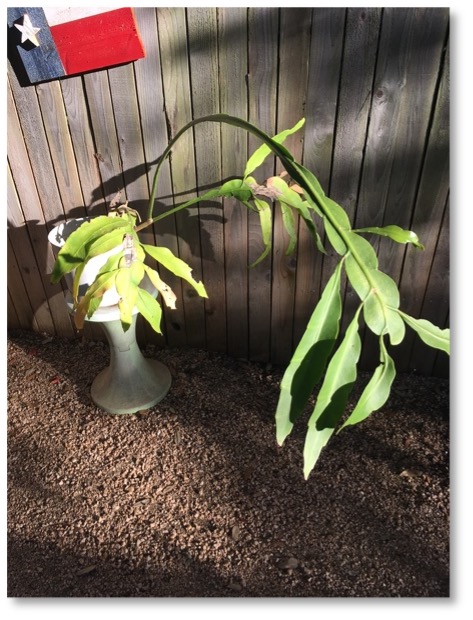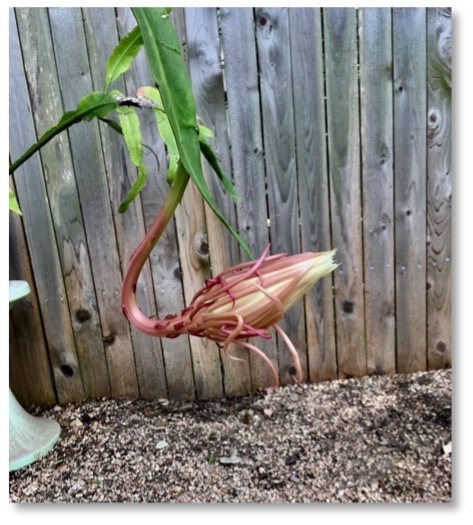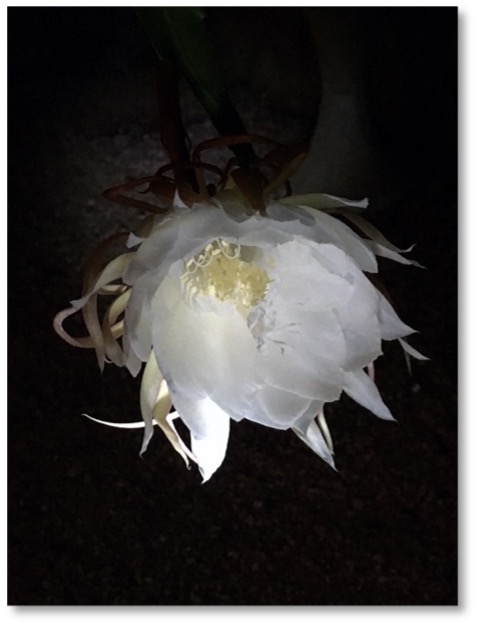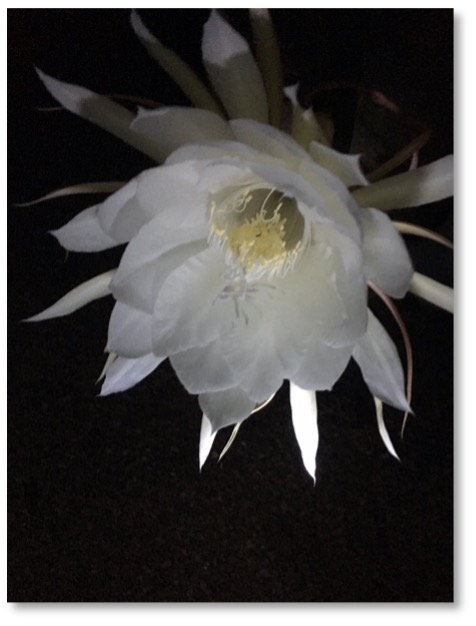Let me introduce you to my Epiphyllum oxpetalum. You may know her as Queen of the Night, Night Blooming Cereus or Night Blooming Cactus. What do you think? Isn’t she a beauty? Doesn’t she radiate majestic splendor? Ok, maybe just a hint of potential attractiveness? What, she’s not speaking to you? You’re not feeling her royalness? Not even a little twinge of charm? Well, you are not alone. I was completely underwhelmed the first time I saw her.
She was given to me by my husband’s elderly cousin, Lallie, who lived in Albany, Georgia. Lallie told me it had the most magnificent flowers that bloomed once a year and only at night. Lallie also told me stories of the many watch-parties she hosted over the years as her neighbors gathered in her yard at dusk hoping to see the magic unfold. Seriously? This scraggly looking plant? For real? I was skeptical. At the same time, I felt Lallie was entrusting me with a family heirloom which is a serious responsibility…no pressure at all!
We dutifully brought this plant home to San Antonio, but I had no idea what to do with it. There it was, all scraggly, awkward and gangly.
I kept the plant in its original pot and set it out in my backyard in full sun because it’s a type of cactus, so it should be able to handle full Texas sun, right? I rarely watered it because it’s a cactus and they don’t require much water, right? Nope, I was wrong on both counts. I noticed my Queen of the Night was not looking very happy, not thriving at all, and was just downright miserable. I did some research and learned all about caring for my family heirloom. Turns out she prefers a respite from the afternoon sun and likes a drink of water once every two weeks.

I moved this now sun-bleached, scraggly and awkward plant to a morning sun location and watered it every other week as suggested by my research. It started to look better in short order, so I patted myself on the back for being such a great caretaker. Crisis averted!
Fast-forward a year. I noticed what appeared to be a small new leaf emerging from a gangly stem. Wow…this plant must be happy now! My caretaking skills were paying off! On closer examination, I realized this was not a leaf, but a FLOWER BUD! My excitement was through the roof! I anxiously inspected the bud every morning while the bud stem grew longer, and longer, and longer each day.
Then the stem made a peculiar curve upward, and the bud was now poised for its debut in my garden. Nature is fascinating, isn’t it? I was intrigued by the turn of events. I could not have been more excited!

As a newbie to this process, I had no idea how long the bud would take to open. Would it be tonight? Tomorrow night? Maybe another couple of days? Who knows? After many days observing the bud develop and grow, I totally missed the bloom, only to find a spent flower the next morning.
I was crushed, disappointed and felt awful for missing my chance to see this elusive flower. And yet hope springs eternal and I never gave up. It took two years of quiet, patient observation to finally figure out when my Queen of the Night flower bud would actually open. I managed to watch and document this marvelous slow dance.
My Night Blooming Cactus performed as if on cue Friday night, June 5th and I captured her beauty in various stages of opening. Please enjoy the grandeur, grace and elegance of this bloom. The scent was heavenly, and this flower is unmatched in its incredible slow reveal. It is joyful and gratifying to see one of nature’s elusive creations unfold. Lallie would be pleased.

I discovered many interesting facts as I was researching the Queen of the Night. It is a perennial that thrives in hardiness zones 10 and 11. Here in San Antonio, grow it in a pot that can be moved indoors, or to your garage or greenhouse when there is a threat of freezing temperatures. This plant will not survive temperatures below 32 degrees. Queen of the Night prefers partial shade and is well suited to a morning sun location.
Watering needs vary depending on the time of year. Over-watering can be a fatal mistake, as this causes the roots to rot. From spring through fall, the plant should be watered once every two weeks. During winter, cut way back on the water…once every 5 weeks.
From spring through fall, it can be fertilized once a month with a low nitrogen fertilizer. Too much nitrogen increases the green growth but doesn’t encourage flowering.
Propagation involves a leaf cutting of approximately 4 inches, taken during the growing season (spring through fall). Dip the cut end into rooting hormone powder. Let the cutting dry for a week until it develops a callus then plant it callus-side down into a pot filled with cactus potting mix and firm it into place. Keep the soil moist, but not wet, during rooting.
Written by: Erica Dozier, Bexar County Master Gardener Intern
First Published: 7/1/2020
For more information:
Orchid Cactus – Epiphyllum by Cal Peterson. Oregon State Extension Service. (https://extension.oregonstate.edu/gardening/flowers-shrubs-trees/orchid-cactus-epiphyllums
Photos courtesy of Erica Dozier, BCMG Intern

